High stability and low noise laser-diode end-pumped Nd: YAG ceramic passively Q-switched laser at 1123 nm based on a Ti3C2Tx-PVA saturable absorber
Jia-Le Yan(閆佳樂), Ben Li(李奔), Guo-Zhen Wang(王國珍), Shun-Yu Yang(楊順宇),Bao-Le Lu(陸寶樂),2, and Yang Bai(白楊),2,?
1Institute of Photonics&Photon-Technology,Northwest University,Xi’an 710127,China
2Shaanxi Engineering Technology Research Center for Solid State Lasers and Application,Xi’an 710127,China
Keywords: passively Q-switched,pulsed laser at 1123 nm,Ti3C2Tx-PVA film,frequency selection and filtering of Brewster polarizer(BP)and birefringent crystal(BC)
1.Introduction
The 1123 nm near-infrared laser, as widely recognized,generated through stimulated radiation from the4F3/2energy level to the4I11/2energy level in Nd: YAG crystal or Nd:YAG ceramic,has been extensively applied in specialized fields such as biotechnology, laser displays, and frequency conversion.[1–3]For example, 1123 nm laser has been used to remote sensing atmospheric water vapor concentration.In the domains of RGB color displays,printing,and data recording, the 1123 nm laser serves as a pump source for thulium up-conversion fiber lasers to generate blue-light emission at 481 nm.[4–6]Additionally,the 561 nm yellow-green laser generated by the frequency doubling 1123 nm is an ideal laser source for dermatology,bioluminescence detection,and holographic storage.[7–9]
However, the absence of active frequency selection and filtering results in significant output noise in the 1123 nm pulsed laser.This is due to the fact that the Nd:YAG crystal or Nd: YAG ceramic generates three spectral lights at 1112 nm,1116 nm and 1123 nm through stimulated emission.[10–12]The stimulated-emission cross section values are similar for 1123 nm and the other two spectral lights, and they have a small wavelength difference.Achieving simultaneous suppression of the spectral lights at 1112 nm and 1116 nm using anti-reflection coatings is not feasible.
To address mode competition from 1112 nm and 1116 nm, the implementation of Fabry–Perot (F–P) etalons or birefringent crystal(BC)placed according to Brewster angle proves effective in suppression.[13–15]However,the higher losses associated with the use of F–P etalons often result in lower output power and optical-to-optical conversion efficiency of the 1123 nm laser.When using BC, it becomes critical to accurately adjust the Brewster angle and the angle between the BC surface and the optical axis of the 1123 nm spectral light.The intricacies involved in these adjustments often present challenges in achieving a stable output for the 1123 nm laser.
As an emerging two-dimensional material in recent years,titanium carbide Ti3C2Txfilm has garnered significant attention in the field of passivelyQ-switched laser due to its advantages such as controllable electronic band structure, a wide range of nonlinear optical response, high optical damage threshold, and large nonlinear absorption coefficient.However, the majority of existing reports on Ti3C2Txtwodimensional film used as a SA in passivelyQ-switched lasers focus on wavelengths at 1.06 μm, 1.3 μm, 2.73 μm, and 3μm.[16–19]Few of the reports are about Ti3C2Txused as an SA for passivelyQ-switched lasers at 1123 nm.
Here, we report a first demonstration, to the best of our knowledge,of a passivelyQ-switched pulsed laser at 1123 nm using a“Ti3C2Tx-PVA film passivelyQ-switching”combined with “frequency selection and filtering of Brewster polarizer(BP)+BC” technology path.A new two-dimensional (2D)material Ti3C2Tx-PVA film was employed to demonstrate the passivelyQ-switched pulsed laser at 1123 nm with high repetition frequency.The combined use of BP and BC reduced the number of longitudinal modes of the passivelyQ-switched pulsed laser at 1123 nm in the cavity while suppressing intracavity oscillations in two spectral lines at 1112 nm and 1116 nm, which was conducive to the improvement of the power stability and the reduction of its noise.A passivelyQ-switched pulsed laser at 1123 nm with an average power of 457.9 mW, a pulse width of 56 ns, a power-instability of±0.92%, and a laser noise of 0.89% width at the repetition frequency of 1.09 MHz were obtained.
2.Material fabrication and characterization
The process of preparing Ti3C2Tx-PVA film is as follows:Initially, 1.0 g of LiF powders were placed in 20 mL of HCl solution (10 mol/L) and stirred continuously.Once the LiF powders were completely dissolved, 1.0 g of Ti3AlC2powders were slowly introduced to the above solution and the reaction was carried out at 36?C for 36 h.Next,the solution was further diluted with deionized water and subjected to multiple centrifugation cycles at a centrifuge speed of 5000 r/min for 5 min each until the pH of the supernatant reached approximately 6–7.The resulting precipitate was then transferred to a vacuum drying oven, where it was dried at 40?C for 24 h,yielding the Ti3C2Txpowders.
Secondly,50 mg of Ti3C2Txpowders were introduced in a mixed solution comprising 150 mL of deionized water and 150 mL of anhydrous ethanol.The mixed solution was subjected to 30 min of continuous sonication to further reduce the number of layers of the Ti3C2Txpowders.Subsequently, the sonicated mixed solution was centrifuged for 10 min using a centrifuge at 7000 r/min and then its supernatant containing the Ti3C2Txnanosheets was extracted.
The supernatant was analyzed using confocal Raman spectroscopy excited with a 1064 nm laser.Figure 1(a)illustrates the presence of four characteristic peaks at 148 cm-1,202 cm-1, 403 cm-1, and 620 cm-1, providing confirmation of the fabricated material being Ti3C2Tx.[20]The Ti3C2Txnanosheets were characterized using an atomical force microscopy (AFM).As shown in Fig.1(b), the thickness analyzed from the profile is about 3.5 nm.Based on the research conclusion that the layer spacing of the Ti3C2Txnanosheets is about 0.99 nm,[21]it is concluded that the number of layers of the Ti3C2Txnanosheets prepared in this study is 3–4 layers.

Finally,0.5 g of PVA powders were dissolved in 50 mL of deionized water at a temperature of 90?C,and the solution was magnetically stirred for 1 h to fully dissolve the PVA powder.The PVA solution was mixed with the supernatant containing Ti3C2Txat a volume ratio of 1:1 and subjected to continuous sonication for 1 h.The sonicated Ti3C2Tx-PVA mixed solution was then uniformly spin-coated using a spin coater onto a surface of sapphire glass with a thickness of 0.2 mm.The coated samples were dried in a thermostatic chamber at 80?C for 24 h, resulting in the fabrication of a Ti3C2Tx-PVA film.The thickness of the Ti3C2Tx-PVA film on the sapphire glass was measured to be 15.3μm using a thickness gauge.
The transmittance versus illumination intensity of the Ti3C2Tx-PVA film was obtained using a balanced twindetector system.The light source of the detection system is a 1064 nm mode-locked fiber laser with a pulse width of 14 ps and a repetition frequency of 28.8 MHz, operating close to 1123 nm.As shown in Fig.1(c), the transmittance exhibits a trend of first enhancement and then saturation with the pulse intensity, confirming that the Ti3C2Tx-PVA film can be used as an SA.The nonlinear optical transmittance of the Ti3C2Tx-PVA film can be fitted using the most common SA model[22]
whereTdenotes the transmittance;αsandαnsdenote saturable absorption component (also termed the modulation depth)and non-saturable absorption component,respectively.IandIsatdenote the incident light intensity and the saturation light intensity,respectively.
As evident from the results presented in Fig.1(c), there is a high degree of agreement between the experimental data and Eq.(1).The calculated saturation light intensity and modulation depth of the Ti3C2Tx-PVA film near 1μm wavelength are 2.12 MW/cm2and 6.47%,respectively.In addition,a thermally conductive copper sheet is attached to each side of the Ti3C2Tx-PVA film coated sapphire glass,and a square copper heat sink is attached to one of the thermally conductive copper sheets,as shown in Fig.1(d).This arrangement enhances the natural heat dissipation efficiency and alleviates stability and reliability concerns of the Ti3C2Tx-PVA film during long-term operation caused by insufficient heat dissipation.
3.Experimental setup
A linear-cavity for a passivelyQ-switched pulsed laser at 1123 nm using a Ti3C2Tx-PVA film as an SA is shown in Fig.2.A Nd: YAG ceramic(2 mm×2 mm×6 mm,0.5 at.%Nd3+doped)was water-cooled at 16?C and was end-pumped by an 808 nm continuous wave laser-diode (LD) with a total pump power of 5.1 W.Two symmetrically positioned G2 plano-convex lenses were used to collimate and focus the LD pump laser.A focused beam with a focal length of 3.4 mm and a focal spot radius of 250 μm was formed behind the pump surface of the Nd: YAG ceramic.The pumped end surface of the Nd: YAG ceramic was coated with anti-reflection(AR)coatings covering the wavelengths of 808 nm(reflectivity,R<1%), 946 nm (R<5%), 1064 nm (R<0.5%) and 1319 nm (R<5%), as well as high reflection (HR) coatings covering the wavelength range from 1100 nm to 1130 nm(R>99.5%).The other end surface was anti-reflection(AR)coated for wavelengths from 1064 nm to 1319 nm(R<0.5%).Mirror M was the output mirror of the 1123 nm laser.Its intracavity concave surface was coated with AR-coatings covering the wavelength range from 1110 nm to 1125 nm(transmittance,T ≈4%)and AR-coatings covering the wavelengths of 1064 nm (R<5.0%), 946 nm (R<5.3%), and 1319 nm(R<7.5%).Its plane surface was coated with anti-reflection(AR)coatings the wavelength range from 1064 nm to 1319 nm(R<0.6%).BP was made of fused quartz glass with a size of 6.0 mm×6.0 mm×0.5 mm,while BC is made of quartz crystal with a size of 6.0 mm×6.0 mm×2.5 mm.The optical axis of BC was parallel to the diagonal at 45?above its incident surfaces.The transparent surfaces of BP and BC were not coated.The size of the sapphire glass coated with the Ti3C2Tx-PVA film on one side was 8.0 mm×8.0 mm×0.2 mm.
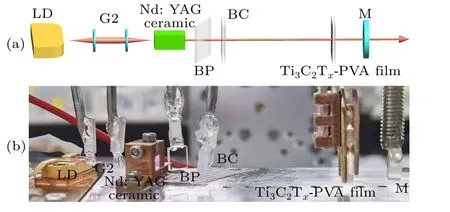
The thermal focal length of the Nd: YAG ceramic was measured using a dynamic testing method.[23]The results indicated a decrease in the thermal focal length from 900 mm to 500 mm when the pump power of the LD increased from 1 W to 6 W.The cavity structure of the 1123 nm laser was optimized based on the ABCD matrix theory, taking into account the measured thermal lens focal length.Ultimately,the curvature radius of the output mirror M was determined to be 250 mm,and the length of the cavity was 45.2 mm.In the cavity range from the output end surface of the Nd: YAG ceramic to the concave surface of the output mirror M,the distance between the two adjacent optical elements was 4.5 mm,4.5 mm,21.0 mm, and 6.5 mm, respectively.When the thermal focal length changed from 900 mm to 500 mm,the stability parameters (A+D)/2 of the sagittal and tangential components at 1123 nm within the cavity experienced changes from 0.49 to 0.41 and 0.52 to 0.45, respectively.According to the stable oscillation condition of|(A+D)/2|<1,the cavity is not sensitive to heat.[24]
4.Result and discussion
According to Fresnel’s law, non-polarized light at 1123 nm that passes through BP separates into p- and spolarized light.The reflectivity of the two polarizations on the BP face can be expressed as follows:[25,26]
whereRpandRsdenote the reflectivity of p- and s-polarized lights, respectively.θandωdenote the incident angle and refraction angle of the non-polarized light,respectively.
For BP made of optical quartz glass,the refractive indices(ni) at 1112 nm, 1116 nm, and 1123 nm are provided by the manufacturer as 1.444,1.435,and 1.424,respectively.Assuming the refractive index of air as approximately 1,the relationship between Brewster’s angleΦi,ni,θ,andωare as follows based on Brewster’s law and the law of refraction:
whereidenote the wavelengths of 1112 nm, 1116 nm, and 1123 nm,respectively.TheΦican be calculated as 55.31?at 1112 nm, 55.12?at 1116 nm, and 54.92?at 1123 nm using Eqs.(4)and(5),respectively.
As shown in Fig.3,only theRpof the p-polarized light at 1123 nm is zero atα=Φ1123=54.92?.The result is that the ppolarized light at 1123 nm only achieves oscillation in the cavity due to the lowest reflection loss on the BP face by precisely adjusting the horizontal and pitch angles of the output mirror M.And the other two wavelengths at 1112 nm and 1116 nm are suppressed due to the roundtrip reflection loss caused by non-zero reflectivity (~0.48% at 1112 nm and~0.88% at 1116 nm in the cavity,respectively).
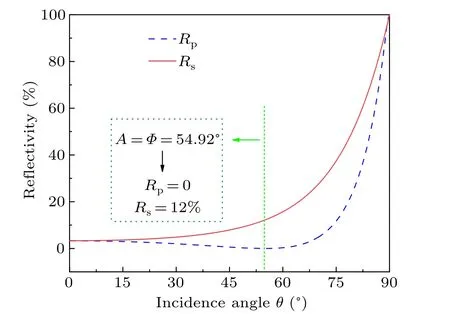
Meanwhile,BC is introduced where its transmission surface is perpendicular to the p-polarized 1123 nm laser.Leveraging the inherent birefringent effect,BC splits the p-polarized 1123 nm laser into an ordinary light (o-light) and an extraordinary light(e-light).After a single round-trip through BC,a phase delay ??is induced between the o-light and e-light[27]
whereD= 2.5 mm represents the thickness of BC.λ=1123 nm represents the laser wavelength.noandnedenote the refractive indices of the o-light and the e-light,respectively.
Rotating BC around the optical axis of the cavity, the ppolarized light at 1123 nm undergoes a 180?rotation after a single round trip through BC when the angleβbetween the ppolarized light at 1123 nm and the optical axis of BC becomes 45?,corresponding to a 2πmultiple of ??:[28]
wherem=0,±1,±2,±3,...
Since the p-polarized direction has not changed,only the longitudinal modes at 1123 nm withm=0,±1,±2,±3,...can achieve low-loss oscillation in the cavity.At 1123 nm,the remaining longitudinal modes will be suppressed.It should be emphasized that the round-trip transmittance of p- and spolarized laser beams in the cavity after passing BC is given by the following equations:[29]
whereTpandTsdenote the transmittance of p-and s-polarized lights, respectively.n*idenote the refractive indices of BP made of optical quartz glass at wavelengths of 1112 nm,1116 nm,and 1123 nm,respectively.
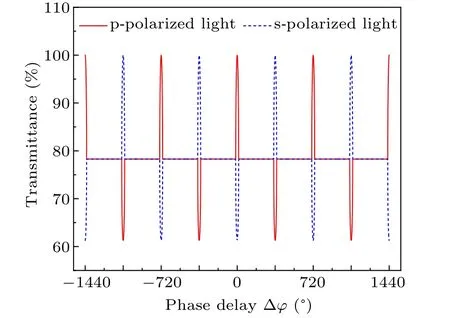
Figure 4 shows the solution ofTpandTsa function of??.The upper line corresponds toTpand the lower one toTs.These two lines join to form a single line at the angle of about 14?and the transmittance of about 78.3%.This figure indicates the zero round-trip loss at ??=2mπ(mis even) for the 1123 nm p-polarized laser beam.However,the phase delays ??*of the two adjacent p-polarized spectral lines at 1112 nm and 1116 nm will not satisfy Eq.(7).The refractive indices of o- and e-light of quartz crystals at 1112 nm, 1116 nm and 1123 nm are (n*o-1112 = 1.5309,n*e-1112 =1.5446), (n*o-1116 =1.5308,n*e-1116 =1.5445) and(n*o-1123=1.5307,n*e-1123=1.5443),respectively.According to Eqs.(6)and(7),it can be derived that the additional phase delays ??*of the 1112 nm and 1116 nm spectral lines with respect to 1123 nm after round-trip passage through BC are 6.5854?and 5.1988?, which correspond to a transmittance of~97.17%and~98.28%,respectively.BC attaches a roundtrip reflection loss of~2.83%and~1.72%for the two spectral lines 1112 nm and 1116 nm (mis zero or even), respectively.Whenmis odd, the three spectral lines at 1112 nm,1116 nm, and 1123 nm are suppressed due to the high reflectivity (about 40%) when passing through BC.The above results indicate that both BP and BC have the capability to suppress oscillation of the 1112 nm and 1116 nm spectral lines in the cavity.The synergistic utilization of BP induces BC to exhibit greater reflective losses for the 1112 nm and 1116 nm spectral lines,thereby further enhancing the cavity’s suppression capability towards these two lines.In summary,the combined use of BP and BC not only ensures that only the 1123 nm laser oscillates and is amplified in the cavity,but also reduces the number of longitudinal modes in the 1123 nm laser, thereby achieving filtering and noise reduction in the 1123 nm laser.
4.1.BP and BC are not placed in the cavity
When BP and BC are not used, a passivelyQ-switched pulsed laser based on cavity finely tuning is observed when the LD pump power reaches 1.26 W,as shown in Figs.5(a)–5(d).Continuing to increase the LD pump power,the repetition frequency of the laser pulse train gradually increased while the pulse width was gradually compressed.This is attributed to the increasing trend of laser power density in the cavity with the increasing LD pump power,allowing the Ti3C2Tx-PVA film to reach the absorption saturation state for a shorter time period.When the LD pump power was increased to the maximum value of 5.1 W,the maximum average power of the passivelyQ-switched pulsed laser with a maximum repetition frequency of 909 kHz reached 365.2 mW, corresponding to an oblique efficiency of 9.5% and an optical to optical conversion efficiency of 7.1%,respectively.The narrowest pulse was 70 ns.However, the three spectral lights at 1112 nm, 1116 nm, and 1123 nm oscillated simultaneously in the cavity lacking frequency selection and filtering of BP+BC.
Using a splitter mirror (with a transmittance of~96%and a reflectivity of~4% at 1123 nm), a power meter, an oscilloscope, and a PIN-type silicon photodiode, the power stability and laser noise of the passivelyQ-switched pulsed laser at 1123 nm were simultaneously measured at maximum output power.The duration and interval of the measurement were 4 h and 2 s, respectively.The power meter was used to measure the power instability of the transmitted pulsed laser at 1123 nm(Fig.6(a)).In contrast,two PIN-type silicon photodiodes and an oscilloscope were employed to measure the laser noise of the reflected pulsed laser at 1123 nm(Fig.6(b)).The silicon photodiode generated an electrical signal that was split in two.With an optical shutter blocking the laser beam,the electrical signal into the channel 1#(AC-coupled mode)of the oscilloscope represented background noise (areaΓB-RMS in Fig.6(b), blue curve).Removing the optical shutter, the electrical signal into channel 1#represented total noise (areaΓT-RMS in Fig.6(b), blue curve), including the laser noise of the pulsed laser at 1123 nm and background noise, while the electrical signal into channel 2#(DC-coupled mode)of the oscilloscope represented the absolute intensity of the pulsed laser at 1123 nm (areaΓI-RMS in Fig.6(b), red curve).The power instabilityρand the noiseΓL-RMS of the passivelyQ-switched pulsed laser at the maximum average power were measured to be±5.23%and 5.21%within a 4 h period using the following equations:[30,31]
wherePMAX,PMIN, andPAMdenote the maximum, minimum, and arithmetic mean values of the detected laser average power, respectively.ΓB-RMS,ΓT-RMS, andΓI-RMS denote the RMS-background noise, the RMS-total noise, and the RMS-absolute intensity,respectively.The poor output stability indicates that it is necessary to suppress the oscillation of the 1112 nm and 1116 nm spectral lights in the cavity to achieve stable output of the passivelyQ-switched 1123 nm pulsed laser.
4.2.BP frequency selection in the cavity
A BP was inserted into the above unfiltered cavity, and its horizontal angle was precisely adjusted to match the Brewster angle(54.92?at 1123 nm).As shown in Figs.7(a)–7(d),the presence of the spectrum line at 1123 nm only in the collected laser spectrum indicates that the BP suppresses intracavity oscillations at 1112 nm and 1116 nm.The insertion of BP increased the threshold of LD pump power from 1.26 W to 1.86 W.However, the effective suppression of the intracavity oscillations for the spectral lines at 1112 nm and 1116 nm mitigates mode competition and enhances the gain of the spectral line at 1123 nm.At 1123 nm at the maximum LD pump power of 5.1 W,the passivelyQ-switched pulsed laser had the maximum average output power of 405.3 mW,the maximum repetition frequency of 1.01 MHz, the narrowest pulse width of 63 ns,and the narrowest line width of 0.95 nm.The measuredρandΓL-RMS decreased to±1.84%and 2.55%after continuous monitoring for 4 h with an interval of 2 s,respectively.
4.3.Frequency selection and filtering of BP + BC in the cavity
On the basis of BP frequency selection,a BC was inserted into the cavity.The horizontal and pitch angles of BC were precisely adjusted with the aim of ensuringβ=45?.BC filtering reduces the number of longitudinal modes in the cavity,thereby alleviating mode competition between longitudinal modes in the passivelyQ-switched pulsed laser at 1123 nm.On the one hand, the longitudinal modes that satisfy Eq.(7)and m is zero or even can achieve higher gain,while on other hand the combination of BP and BC is more effective in suppressing intracavity oscillation of spectral lines at 1112 nm and 1116 nm.As shown in Figs.9(a)–9(d), although BC further increased the pump threshold of LD to 2.84 W, the passivelyQ-switched pulsed laser at 1123 nm obtained the better output characteristics.As a result,the average power of the passivelyQ-switched pulsed laser at 1123 nm with a maximum repetition frequency of 1.09 MHz reached 457.9 mW under the maximum LD pump power of 5.1 W.Meanwhile, a narrowest pulse width of 56 ns and a narrowest spectral line width of 0.65 nm were measured.This is because, the power density of the passivelyQ-switched pulsed laser at 1123 nm with partial longitudinal mode suppressed significantly increases,which allows the Ti3C2Tx-PVA film to reach absorption saturation at a shorter period and higher frequency.[32,33]At higher power density,the time required for the excited energy level of the Ti3C2Tx-PVA film to enter saturation is shorter, thus obtaining higher repetition frequency and shorter pulse width.[34]Continuously monitoring the maximum average power of the passivelyQ-switched pulsed laser at 1123 nm for 4 h with an interval of 2 s, theρandΓL-RMS were reduced to±0.92%and 0.89%,respectively.The results demonstrate that the frequency selection and filtering of BP+BC have jointly suppressed the noise in the passivelyQ-switched pulsed laser at 1123 nm by reducing both the number of wavelengths and longitudinal modes in the cavity.Considering the adopted thermal management measures,the stable output of the passivelyQ-switched laser over duration of 12 h also demonstrates the excellent operational reliability of the Ti3C2Tx-PVA film as SA from another perspective.
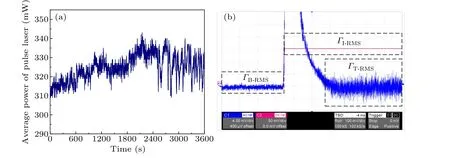
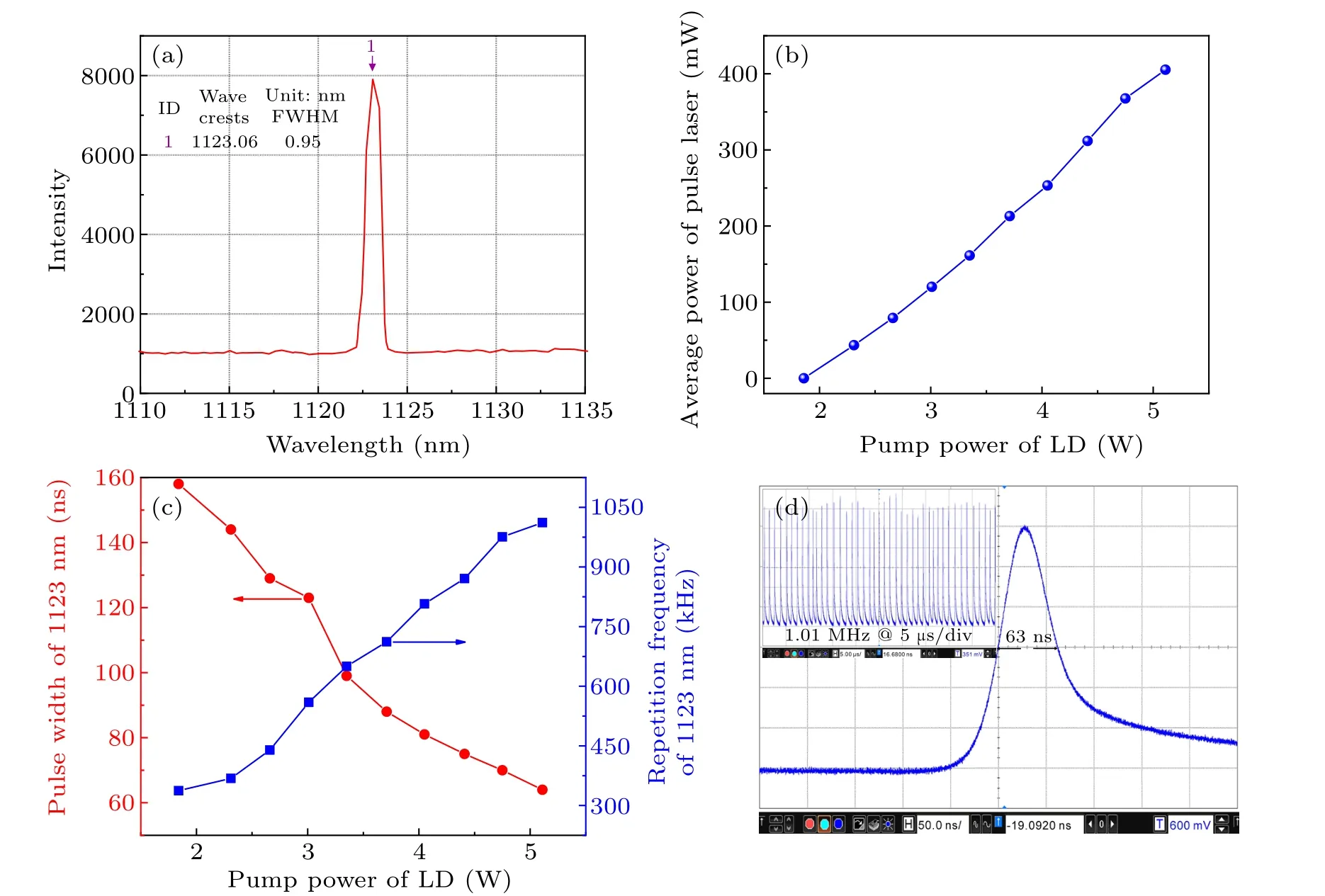
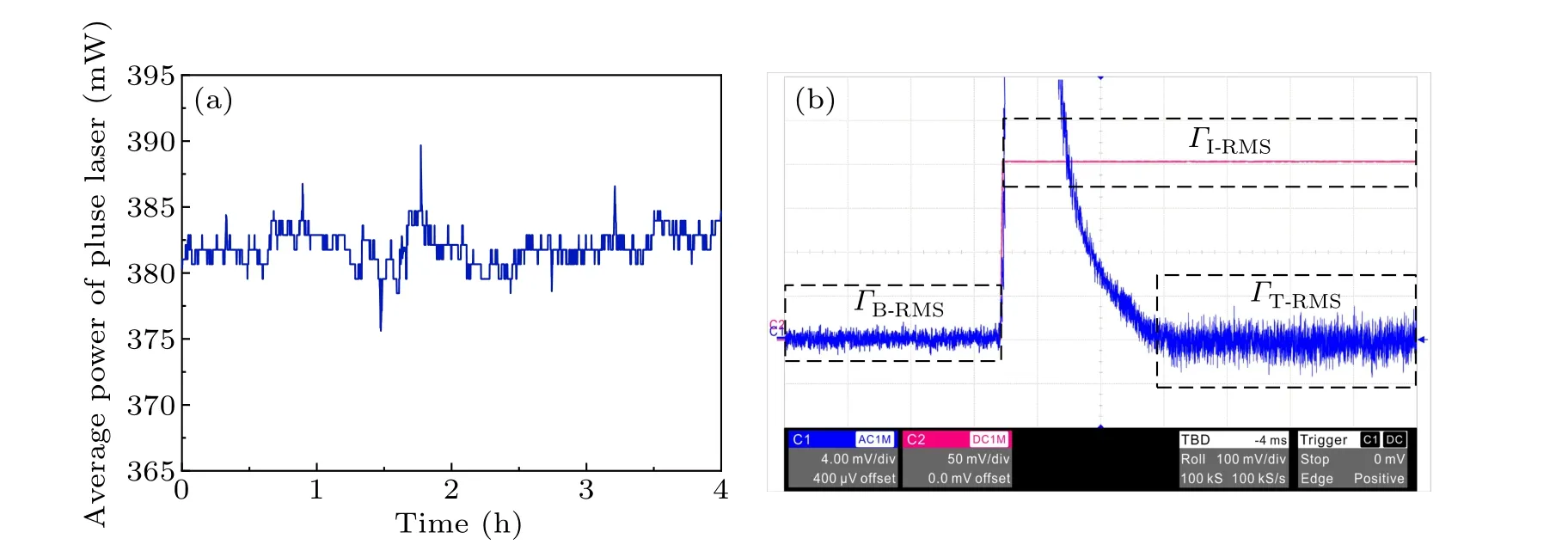

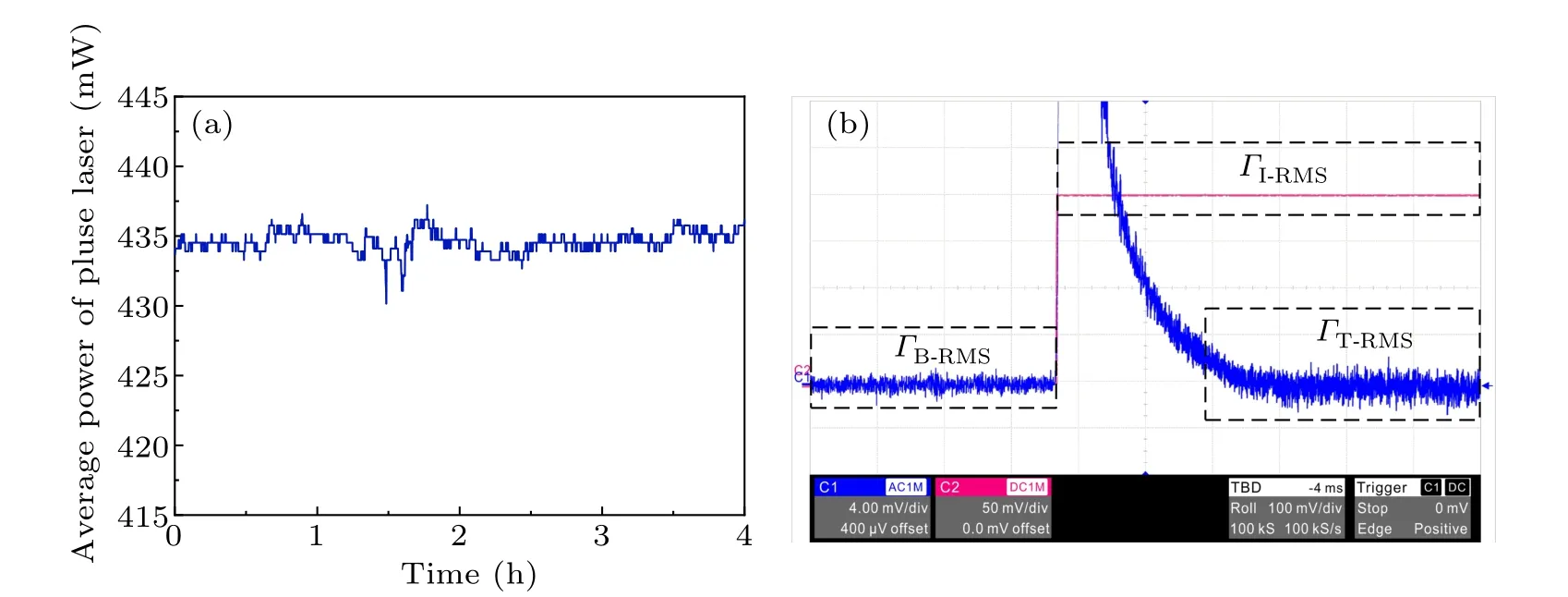

In addition, the beam qualityM2factors of the three passivelyQ-switched 1123 nm pulsed laser beams, as measured by a laser beam quality analyzer were found to be(M2x=5.814,M2y=5.428), (M2x=3.466,M2y=3.288), and(M2x=2.505,M2y=2.177),respectively.The 2D and 3D images of the near-field beam are shown in Fig.11.The smaller beam qualityM2factors further confirm that the “frequency selection and filtering of BP+BC”contributes to the improvement of beam quality for the passivelyQ-switched 1123 nm pulsed laser.
5.Conclusion
In this work, a solid-state pulsed laser at 1123 nm with high repetition frequency, high power stability and low laser noise based on a Ti3C2Tx-PVA film passivelyQ-switching combined with“frequency selection and filtering of BP+BC was proposed.The maximum average power of 457.9 mW,maximum repetition rate of 1.09 MHz,narrowest pulse width of 56 ns, and narrowest line width of 0.65 nm were obtained simultaneously,with corresponding the power instability and the laser noise only at±0.92% and 0.89%, respectively.Our first proposed “Ti3C2Tx-PVA film passivelyQswitching” combined with “frequency selection and filtering of BP+BC” technology path will be of great significance in promoting the wider application of passivelyQ-switched pulsed laser at 1123 nm with high repetition frequency, high power stability, and low noise in the fields of biotechnology,laser display, frequency conversion, and high-resolution optical sensing.
Acknowledgments
Project supported by the Serving Local Special Project of Shaanxi Provincial Department of Education of China(Grant No.19JC040)and the National Natural Science Foundation of China(Grant No.61905193).
- Chinese Physics B的其它文章
- Optimal zero-crossing group selection method of the absolute gravimeter based on improved auto-regressive moving average model
- Deterministic remote preparation of multi-qubit equatorial states through dissipative channels
- Direct measurement of nonlocal quantum states without approximation
- Fast and perfect state transfer in superconducting circuit with tunable coupler
- A discrete Boltzmann model with symmetric velocity discretization for compressible flow
- Dynamic modelling and chaos control for a thin plate oscillator using Bubnov–Galerkin integral method

